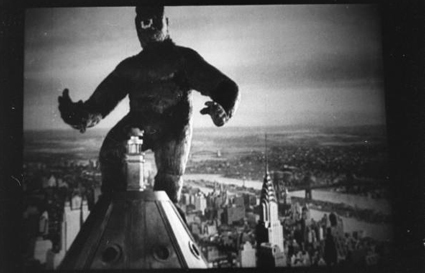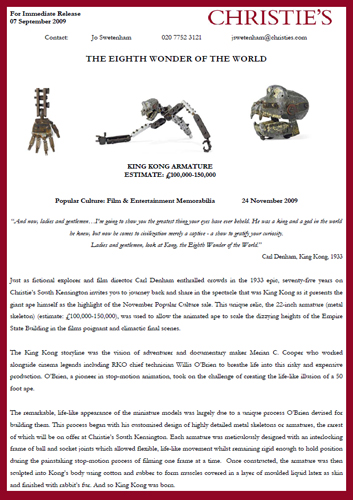The next Christie’s “Pop Culture” auction event, scheduled for November 24, 2009 at their South Kensignton location in the UK, will feature one of the original stop-motion armatures from King Kong (1933). This piece is expected to realize a very high price at auction, as it is an extremely important artifact from a truly classic film.

Below is a PDF of the official Christie’s press release:
Below is an excerpt from the press release which provides background as to the development, use, and importance of the artifact:
King Kong Armature
Volumes have been written about the making of the 1933 masterpiece of stop-motion animation King Kong and the extraordinary technical achievements this film embodied.
In brief: stop-motion animation is a process whereby 3-D miniature models are brought to life by filming then one frame at a time and making fractional adjustments to the model’s position between each frame.
RKO’s production of King Kong was groundbreaking for a number of reasons. At the time of its release, audiences were thrilled by the life-like appearance of the fantasy creatures and the intense drama of the action packed story. The artistic genius and technical skill employed in the making of King Kong continues to inspire generations of contemporary filmmakers and moviegoers to this day.
It was adventurer and documentary maker Merian C. Cooper who devised the thrilling story of the giant 50 foot ape; and who with fellow adventurer, colleague and director Ernst B. Schoedsack in 1931 refined the outline of the film’s dramatic concept and persuaded studio executive David O. Selznick to give this risky and expensive production the go-ahead. It was however, another cinema legend, Willis O’Brien whose artistic genius brought the film to life.
Willis O’Brien, Chief Technician at RKO studios, was a pioneer in stop-motion animation. The remarkable life-like appearance of his miniatures was largely due to a unique process he devised for building them. The process began with his customised design of a highly detailed metal skeleton or armature for each model. O’Brien meticulously designed the alloy armature with an interlocking frame of ball and socket joints which were machined in RKO studio’s Miniature Department workshop.
O’Brien’s exquisitely tempered armatures were so flexible that every part of the body could be moved precisely while remaining rigid enough to keep in position during the painstaking process of filming one frame at a time.
Once the Armature had been built from O’Brien’s blueprint, his assistant, sculptor Marcel Delgado, constructed the body by fixing cotton to the ‘skeleton’ and strips of rubber to form muscles. A layer of liquid latex was then painted on to form the skin, which Delgado sculpted with details of wrinkles and folds. The latex skin was then covered with fur. In the case of the armatures for Kong himself, the fur used was rabbit.
Accounts vary as to how many armatures were made for the film’s leading character Kong, however when the expense and complexity of the construction of these is taken into consideration, it is clear that their number was very few.
The scale of the miniatures used in King Kong and in particular that of Kong himself was a major consideration during the process of filming. Delgado is reported as stating that he constructed the bodies of two 18 inch models for Kong. These were based on a one-inch to one-foot scale, making the full size Kong on screen appear to be 18 foot high. The 18 inch. models were apparently largely used on the Skull Island sequences. For the film’s dramatic New York scenes, Cooper ordered O’Brien to increase Kong’s size so that it would make more impact against the imposing sets for the vast New York sky line.
Only one armature for the larger size Kong is believed to have been made and it is this unique relic from the early special effects masterpiece King Kong that is the exceptional highlight of Christie’s Popular Culture auction on November 24th.
This 22 inch King Kong Armature could be described as the best kept secret of the 1933 movie. It has survived until now due to the foresight and tenacity of cinema industry insider and miniature enthusiast Eugene Hilchey. Hilchey’s quest for King Kong artefacts began in 1949 when he first saw and photographed several miniatures from this film, in the miniature department at RKO studios. Over the course of the next few years, Hilchey became chairman of a committee set up to collect motion picture artefacts for a `Hollywood Museum’ project. Hilchey finally received custody of this 22 inch Armature in 1967 when the miniature department where it had been housed, was closed for demolition. Hilchey carefully preserved this remarkable piece and a fascinating archive of accompanying photographs from then until now.
This Armature is truly remarkable on several counts. Not only is it thought to be the only one made of this 22 inch size, it is, as such the one which was specifically developed to be used in the film’s most dramatic moments such as King Kong’s Empire State building sequence cited by Ray Harryhausen and Tony Dalton in their recent authoritative work “A Century of Stop Motion Animation” as: ….one of the iconic moments in the history of model animation, if not in the history of cinema itself…
In the words of Eugene Hilchey “…King Kong’s phenomenon is `universal’ and my desire now is to be able to make it available for people everywhere to see King Kong’s secret – his ‘armature’. For this reason Hilchey has entrusted this truly historic piece to Bison Archives/ Productions, who have brought it to Christie’s with a significant quantity of documentation supporting their meticulous research, so that this Armature can launched onto the world’s stage where it belongs.
The home page for this upcoming Christie’s auction can be found at Christies.com: Popular Culture Department
Jason DeBord


